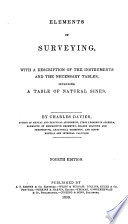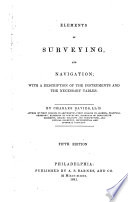 | John Radford Young - 1839 - 332 pages
...be convenient to establish the following characteristic properties of logarithms. (141.) THEOREM 1. The sum of the logarithms of any two numbers is equal to the logarithm of their product. Let b be any number, and let its logarithm be x ; and let с be any other number, whose... | |
 | Charles Davies - Surveying - 1839 - 376 pages
...member by member, we have but since a is the base of the system, ro+n is the logarithm ^/xJV; hence, The sum of the logarithms of any two numbers is equal to the logarithm of their product. Therefore, the addition of logarithms corresponds to the multiplication of their numbers.... | |
 | Charles Davies - Navigation - 1841 - 414 pages
...member by member, we have but since a is the base of the system, m+n is the logarithm JJ/xJV; hence, The sum of the logarithms of any two numbers is equal to the logarithm of their product. Therefore, the addition of logarithms corresponds to the multiplication of their numbers.... | |
 | Charles Davies - Algebra - 1842 - 284 pages
...the logarithms of any two numbers equal ? To what then, will the addition of logarithms) correspond ? The sum of the logarithms of any two numbers is equal to the logarithm of their product. Therefore, the addition of logarithms corresponds to the multiplication of their numbers.... | |
 | James Thomson - 1848 - 326 pages
...logarithms of numbers are other numbers depending on them, and characterized by the property, that the sum of the logarithms of any two numbers is equal to the logarithm of their product. Thus, log 6+log c=log (6c). Hence also, since b=-.c, it follows, that c log6=log-+logc;... | |
 | Charles Davies - Algebra - 1848 - 300 pages
...the logarithms of any two numbers equal ? To what then, will the addition of logarithms correspond ? The sum of the logarithms of any two numbers is equal to the logarithm of their product. Therefore, the addition of logarithms corresponds to the multiplication of their numbers.... | |
 | John Radford Young - 1851 - 266 pages
...as we shall see when a few obvious propositions in the theory of logarithms are stated. 1 1 7. Tne sum of the logarithms of any two numbers is equal to the logarithm of their product. Let a* = n, and a'—n' .: aI+•'=nn'; therefore, if a be the base of the system of... | |
 | Charles Davies - Geometry - 1886 - 340 pages
...Multiplying equations (1) and (2), member by member, we have lO"""" = MxN or, m+n — log MxN : hence, The sum of the logarithms of any two numbers is equal to the logarithm of their productDividing equation (1) by equation (2), member by member, we have " ,m— n M ' M 10 =... | |
 | Adrien Marie Legendre - Geometry - 1852 - 436 pages
...shall have, Multiplying equations (1) and (2), member by member, we have, or, m + n=log (Mx N); hence, The sum of the logarithms of any two numbers is equal to the logarithm of their product. 4. Dividing equation (1) by equation (2), member by member, we have, mn MM 10 -=_r~0r,... | |
 | Charles Davies - Geometry - 1854 - 436 pages
...Multiplying equations (1) and (2), member by member, we have, 10m+ n = Mx N or,m + n=log (Mx N) ; hence, The sum of the logarithms of any two numbers is equal to the logarithm of their product. 4. Dividing equation (1) by equation (2), member by member, we have, JO™ »BB_OTjW_Wesi0g—... | |
| |